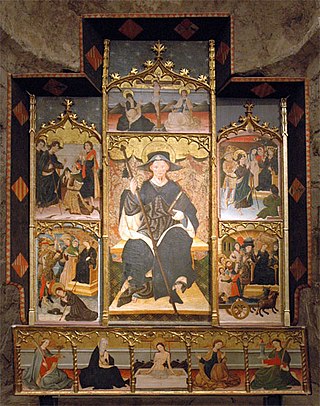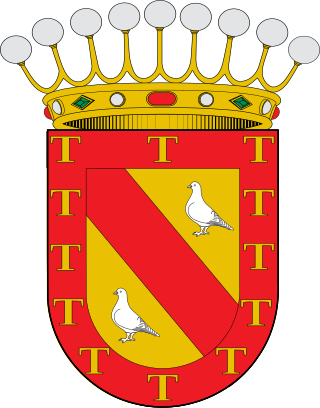
Zaragoza also known in English as Saragossa, is the capital city of the province of Zaragoza and of the autonomous community of Aragon, Spain. It lies by the Ebro river and its tributaries, the Huerva and the Gállego, roughly in the centre of both Aragon and the Ebro basin.

Ramiro I was the first King of Aragon from 1035 until his death, although he is sometimes described as a petty king. He would expand the nascent Kingdom of Aragon through his acquisition of territories, such as Sobrarbe and Ribagorza, and the city of Sangüesa. Sancho Ramírez, his son and successor, was King of Aragon, but also became King of Pamplona.

Isabella of Aragon, was Queen of France from 1270 to 1271 by marriage to Philip III of France.

Elda is a city and municipality located in the province of Alicante, Spain. As of 2009, it has a total population of 55,618 inhabitants, ranking as the 7th most populous city in the province. Elda joins together with the town of Petrer to form a conurbation with over 85,000 inhabitants. The river Vinalopó flows through the urban area of Elda.

Caudete is a municipality of Spain located in the province of Albacete, Castilla–La Mancha. It has a population of 10.163. It is part of the Altiplanicie de Almansa comarca.
José Manuel Mójica Legarre is a Spanish writer. He was born in September 1955, in Aragon, a province in Spain. According to some in the news-media, he is one of the “last adventurers”.

The bat is a heraldic symbol sometimes used as a charge, but most prominently used as a crest on or around the crown in municipal arms of the former Crown of Aragon—specifically in Valencia, Catalonia and the Balearic Islands.

The Capitulations of Santa Fe between Christopher Columbus and the Catholic Monarchs, Queen Isabella I of Castile and King Ferdinand II of Aragon, were signed in Santa Fe, Granada on April 17, 1492. They granted Columbus the titles of admiral of the Ocean Sea, viceroy, and governor-general and the honorific don, and also the tenth part of all riches to be obtained from his intended voyage. The document followed a standard form in 15th-century Castile with specific points arranged in chapters (capítulos).

Borja is a town and municipality in the province of Zaragoza, community of Aragon, northeastern Spain. As of 2014, its population was 4,931.
Juan IV Coloma y Cardona, 1st Count of Elda,, 3rd Sieur of Elda, Governor of Alicante Castle, Count of Elda, Viceroy of Sardinia, 1570-1577.
Ana Francisca Abarca de Bolea (1602–1685) was a Spanish writer and poet born in Zaragoza on 19 April 1602 and died in Casbas (Huesca) around 1685.

Blasco de Grañén was a Gothic painter active in Aragon from 1422. He became the appointed painter to Juan II of Aragon. His notable assistant, among others, was Pedro García de Benavarre, with whom he made the altarpieces for the monastery of San Pedro de Siresa in 1445.

Sancho Ramírez was an illegitimate son of King Ramiro I of Aragon and Amuña, the firstborn and brother of his namesake who would inherit the throne and reign as Sancho Ramírez.
Pedro de Atarés was a Spanish noble and member of the House of Aragón. He founded the Veruela Abbey, the oldest Cistercian monastery in Aragon.

Ana Santos Aramburo is a Spanish librarian who has been the director of the National Library of Spain since February 2013.

Sancha Ramírez was an Aragonese princess, the daughter of King Ramiro I and Queen Ermesinda. She was the countess of Urgell from c.1063 until 1065 as the wife of Count Ermengol III. Her brothers Sancho Ramírez and García Ramírez became king of Aragon and bishop of Pamplona, respectively. During her brother's reign she played an important role in consolidating the Kingdom of Aragon, which had been founded by her father in 1035.

Coloma or de Coloma or Colomba is an old important Spanish Noble House. A branch belongs to the Flemish nobility, and became the Counts of Bornhem. Other branches became the Counts of Elda, Marquesses of Espinar, Marquesses of Noguera and Marquesses of Canales de Chozas.
Miguel Pérez de Almazán was a Spanish hidalgo.

Martín de Soria was a Spanish Gothic painter in the Flemish style; active in the Kingdom of Aragón. His style is related to that of Jaume Huguet and his works have sometimes been confused with that painter's youthful efforts.
Juan Cabrero (1442–1512) was the High Chamberlain and counselor of King Ferdinand the Catholic, Commander and one of the Thirteen of St James Order, and a professional combatant during the Granada War in Spain. High Chamberlain Cabrero is considered an important figure in the History of the 1st Voyage of Christopher Columbus, for he is referred to by Christopher Columbus along with Diego de Deza as the cause of the acceptance of his Indies Enterprise in 1492 by the Catholic Monarchs. Cabrero's pivotal support is also confirmed by Diego Columbus and King Ferdinand.














